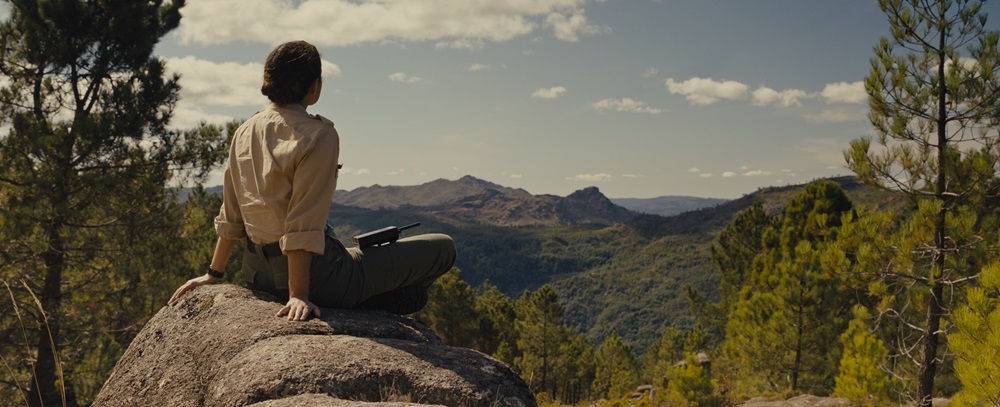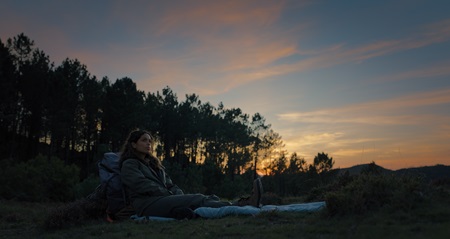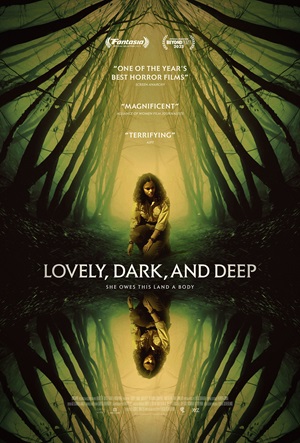
Lovely, Dark, and Deep Hauntingly Lingers in Nature’s Unknown Voids
There is nothing kind about writer-director Teresa Sutherland’s haunting suspense yarn Lovely, Dark, and Deep. Much like her screenplay for 2018’s female-driven Western The Wind, there is danger to be found in the quiet of the forest. In the darkness, fleeting movements rustling just out of eyesight may not be as benign as one assumes. Nature plays tricks upon a weary mind, and right side up becomes upside down in the blink of an eye.
Lennon (Georgina Campbell) is a backcountry ranger working her rookie summer season in a vast California national park, an obsession sparked by a childhood trauma involving her younger sister. Not too long into her 90-day tenure, a female hiker goes missing. Ignoring the direct order of her supervisor Jackson (Nick Blood), and even though her feet are injured, Lennon proceeds deep into the woods, certain she can find the young woman. When she does, the bruised, bloodied, and terrified hiker keeps repeating one question: “Are you real?”
Sutherland’s story may be simple, but the themes she explores are complexly internalized and woundedly intimate. Lennon refuses to believe people can just vanish as if they never existed. She is driven to go above and beyond, no matter what the cost, never dreaming that otherworldly unknowns reside in the impenetrable voids of the forest and, if you take their prey away from them, they will come for you next in their place.
It’s unsettling stuff, and Sutherland isn’t interested in making it easy for the viewer to keep track of what is happening at any given moment. Once Lennon’s encounter with the park’s supernatural inhabitants begins, things quickly become psychologically discombobulating. The line between fact and fiction vanishes. Lennon must deal with the scars left in the wake of her sister’s disappearance, even as she valiantly struggles to maintain her sanity and make it back to civilization before she, too, becomes another photograph of a missing person collecting dust on the ranger station’s bulletin board.
None of this happens right away. I liked that Sutherland took her time before she plunged me into the metaphorical abyss that separated fantasy from reality. We spend time with Lennon as she hikes her section of the park. We get to know many of the landmarks. We see how closely each ranger’s quadrant intersects with the one next to it, and so when the call goes out to search for the missing woman, it’s not surprising how fellow rangers like Lennon can quickly respond to assist in tracking her down.
I did find it interesting that the film was shot almost entirely in Paraguay, and not in an actual California national park. While I’m no expert in sunny Californian topography, I’ve hiked enough of the Pacific Northwest and watched more than my fair share of classic Westerns (not to mention multiple viewings of Return of the Jedi) to know that Lennon, Jackson, and the other rangers aren’t wandering around Yosemite, Redwood, or Sequoia.
No matter. This turns out to be a stroke of genius. There is uneasy, eerie elegance to these Paraguayan locations that’s disquietly ethereal. Cinematographer Rui Poças crafts painterly visuals that are like some insane cross between Bob Ross, Salvador Dalí, Edvard Munch, and Thomas Moran. It’s as if the moment Lennon steps foot into the park, she has been instantaneously transported to an entirely different planet, and Sutherland utilizes this unearthly landscape to perfection.
While I do appreciate Sutherland’s subtlety, the narrative can become impenetrably vague at times, especially during the film’s culminating act. Characters introduced early on reappear suddenly, and I didn’t quite buy a critical turn of events involving veteran character actor Wai Ching Ho (who is in charge of all the rangers) that helps Lennon comprehend what is happening with slightly more clarity than would have otherwise been possible. It’s expository nonsense, and because of this, an act of selfless sacrifice falls a little flat.
But the film’s climactic scene wrecked me. Sutherland brings things to a tragically somber conclusion, and the way the director insists that some mysteries should eternally remain unsolved is both cathartically magical and horrifically unpleasant. Lovely, Dark, and Deep remains true to its title, and the next time I go hiking, come hell or high water, I’m staying on the beaten path.
– Review reprinted courtesy of the SGN in Seattle
Film Rating: 3½ (out of 4)








